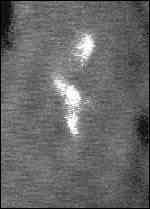 New
evidence shows that the Moon is not a totally dead world as was thought by many
astronomers. It does still occasionally stir with activity.
New
evidence shows that the Moon is not a totally dead world as was thought by many
astronomers. It does still occasionally stir with activity.
More detailed photography has simply complicated the problem. Most astronomers simply gloss over the anomalous evidence that has come to light, or if probed more deeply, debunk and ridicule it. It is an unfortunate fact of human nature that, when our established world view is threatened, we lash out venomously. Scientists are no exception, in fact doubly so, as they have their own specialised knowledge to protect. Cosmic Conspiracies are open to ideas until they are proven erroneous.
BBC
Spot Lights On The Moon!
Below
we have reproduced a recent article on the BBC News website (13th June,2000).
Are we finally starting to hear the truth?
 New
evidence shows that the Moon is not a totally dead world as was thought by many
astronomers. It does still occasionally stir with activity.
New
evidence shows that the Moon is not a totally dead world as was thought by many
astronomers. It does still occasionally stir with activity.
Even though they have been
reported from time to time for hundreds of years, claims of changes on the lunar
surface have always been controversial. Many scientists have dismissed the occasional
reported sightings of glows and mists hanging over certain lunar features.
Light site: The mighty crater Langrenus, 136 km across
Now a French astronomer has obtained some of the best evidence yet that occasionally something does disturb the lunar surface.
It was seen in 1992 by veteran lunar observer Audouin Dollfus of the Observatoire de Paris using the one metre (39 inch) Meudon reflecting telescope. He has only just finished analysing the results, and has submitted them for publication.
 Clouds
of light were seen dancing inside the crater. Each time he returned to the telescope,
he noticed that the shape of the glows had changed.
Clouds
of light were seen dancing inside the crater. Each time he returned to the telescope,
he noticed that the shape of the glows had changed.
He believes that the glows are due to escaping gas that lifts dust above the lunar surface into sunlight. Some lunar observers have expressed surprise that such a mist should have been seen above Langrenus which was not regarded as a prime candidate for lunar changes.
Professor Dolfuss points out that Langrenus, when observed in detail, has an extensive series of fractures on its crater floor and the gas could be escaping from these.
 Responding
to observations from the ground, Neil Armstrong was asked to look for glows
on the Moon during the Moon landing in July 1969. He reported seeing a part
of the Moon glow, but later could not be sure which region it was.
Responding
to observations from the ground, Neil Armstrong was asked to look for glows
on the Moon during the Moon landing in July 1969. He reported seeing a part
of the Moon glow, but later could not be sure which region it was.
In 1994, the Clementine
lunar orbiting satellite observed the crater Aristarchus before and after a
TLP was seen from the Earth. Clementine spectral data suggested that parts of
the crater had changed colour slightly.
Professor Dollfus observes the Moon
Until a few years ago astronomers weren’t sure whether the surface of Titan was rocky or an ocean of liquid hydrocarbons. It was thought that it could only be one or another, that a terrestrial-like mix of continents and oceans was theoretically impossible for Titan. The reason for this viewpoint, put forward by Carl Sagan and Stanley Dermott in 1982, was that Titan’s elliptical orbit around Saturn precluded varied surface geography. The argument goes like this: If Titan had various large bodies of liquid hydrocarbons, then the gravitational forces of Saturn would raise substantial tides, and the resulting tidal friction would have circularised Titan’s orbit in much less than the age of the Solar System. So the surface must be either all-ocean or all-land.
Earth-based experiments
carried out on Titan have produced results, now widely accepted, that directly
contradict this robust theoretical argument. A team led by Duane O. Muhleman
of C.I.T. fired radar pulses at Titan from Earth and used mighty radio telescopes
to read the feeble returns. As Titan turned different longitudes towards
Earth the resultant returns showed land and sea. Titan has both.
Yet it retains an elliptical orbit. Astronomers are looking forward to
the mapping and investigation of this variable terrain by Cassini and Huygens,
but the anomaly has not gone away.
Then what of our Moon? It’s size and composition are at variance with its big sister Earth, yet there it is in our night skies. The Earth had but one continent billions of years ago, the ocean filling in a gaping hole in its side. Some speculate that the Moon was a sizeable chunk of the Earth that somehow broke free and ended up in orbit. Much more sensibly, 12th Planet theory sees the Earth as a remnant of a much larger, watery planet called Tiamat. Tiamat resided in the gap between Mars and Jupiter before being struck by one of Nibiru’s planetary ‘attendants’. The Moon was already around Tiamat, but this would have seemed less incongruous then given Tiamat’s size. Somehow, the remains of this once great planet, now the Earth, managed to hang onto the Moon, which was destined to become a planet in its own right. This is why the Sumerians classified the Moon as on of the 12 planets, seeing the Earth/Moon system as a twin planetary system.
Recently just such proof appeared to have been found. According to ‘Astronomy’ magazine, the Clementine probe’s images of the Moon surface were found to contain data that verified a reported LTP made by the amateur astronomer Robert Manske. The LTP in question was of an “obscuration or darkening” at a collapsed lava tube called the Cobrahead in the Aristarchus region. The graduate student, Sascha Calkins, who found the relevant Clementine image of that region at that moment reported “good quantitative confirmation”. But science can be a cruel mistress. Her boss, Bonnie Buratti of the Jet Propulsion Laboratory, investigated this anomalous finding and “created new calibrations for the Clementine images”. Lo and behold, the event disappeared.
So here we have two independent
findings pointing to an anomalous event having occurred on the Moon, with a
subsequent alteration of one of the findings to allow science to throw the whole
thing in the trash can. Suspicious? We think so. Compare and
contrast with the data reported be amateur astronomers regarding sightings of
meteoric impacts on the Moon’s dark side during the Leonid meteor shower.
The data is immediately accepted by all parties, even though some of the observers
were using smaller telescopes than Mr Manske. This amounts to a clear
double standard, where data is acceptable only if it fits the currently accepted
scientific model. As amateur telescopes continually improve in power,
it seems likely that this kind of academic conflict between amateur astronomers
and mainstream science will increase. Perhaps, one day, the amateurs will
gather sufficient evidence to make science re-evaluate its intransigent position.
Keep up the good work, people.
© Andy Lloyd & Dave Cosnette 2000